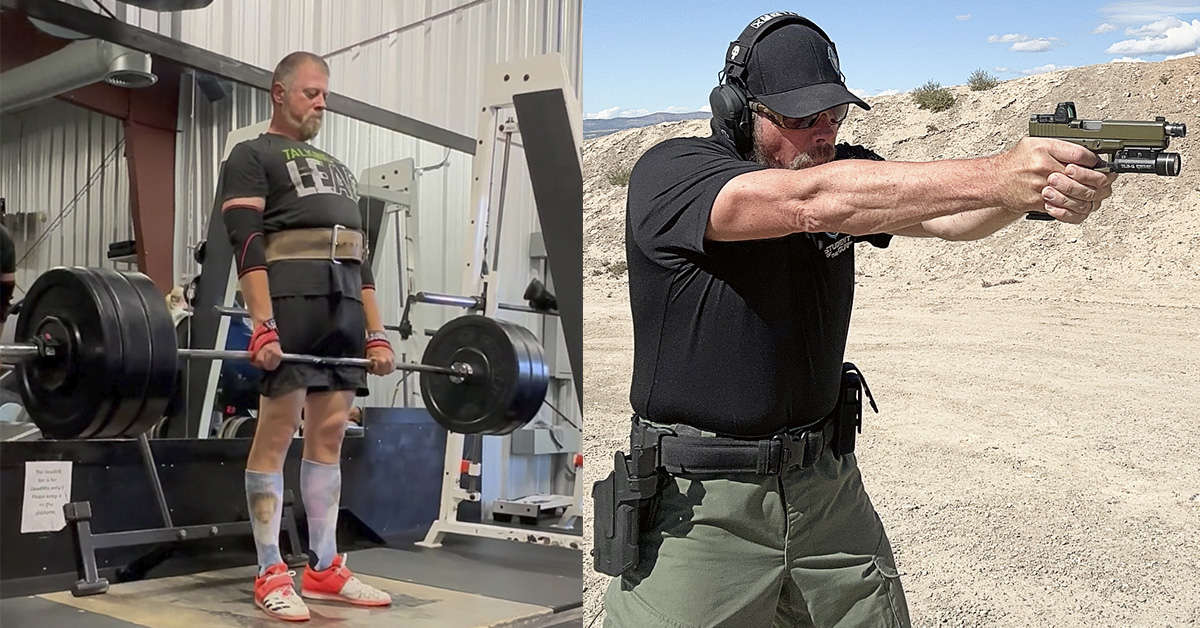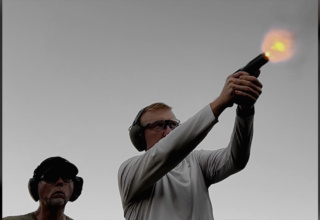A healthy diet and purposeful exercise and weight training are not only good for you, they pay big dividends when you’re behind the gun
by Paul G. Markel
When we read the term “operational fitness,” it is easy to blow it off and think, “I’m not a Seal. I don’t need to be that fit.” For this article, we are going to use the phrase operational fitness as a way to gauge what your firearms instructor should reasonably expect from you when you arrive for training.
I’ve been a small arms and tactics instructor for better than three decades now and have trained military personnel, police officers, and citizens — both young and old. During this piece, I’d like to offer some advice that can potentially make your training experience better as well as help you to get more out of the time you spend on the training range.
You are the Operating System
When I was a small arms and tactics instructor for the US military, all my students used the same armory-stock firearms. No one showed up with a tricked out/custom-built pistol or rifle. At the end of the training program, each student demonstrated their skill during qualification courses. Some barely passed and some scored higher and earned the title of Expert.
In the previous case, every shooter was using stock firearms that were identical, save the serial numbers. They all used the same MILSPEC ammunition. So, if all the guns were the same and everyone was shooting the same ammunition, why did some students score higher than their peers? The answer is simple: it wasn’t the gun or the ammo that brought about the Expert score, it was the individual shooter.
“Duh! Obviously,” some of you just said. While the previous assertion might seem ridiculously obvious, when we consider the American gun community, their behavior demonstrates that this fact is not so obvious. What we witness every day are people who attempt to buy their way around training and skill with “match triggers” and “competition barrels” and “custom-built pistols.”
I’m not saying that quality components cannot make for a better experience. The simple fact remains that you are the operating system for the firearm and no amount of aftermarket competition parts can make up for an operating system that is in poor condition.
Operational Fitness
Running guns is a physical undertaking. The guns don’t shoot themselves, nor do they hold themselves up. It is the human operator that must hold the gun steady and still until the shot breaks and then again for follow up shots.
Before someone in the audience gets indignant or decides to be butt-hurt on someone else’s behalf, I am fully aware that there are shooters who have genuine physical limitations. A few years ago, I was on the range with a gentleman who was a double-amputee and stood on bionic legs. That dude worked harder than everyone in the class and never complained a single time. There is a difference between having a real disability and having an unhealthy addiction to chips and cheesy fries.
For a basic, two-day pistol course, the physical exertion that you are going to have to put forth will be walking around and standing on the range for several hours. You need the hand strength and coordination to run the slide of your pistol for loading and stoppage clearing. At some point, you are going to be asked to move in a rapid fashion to a position of cover to take shots. Most shooting courses will demonstrate and address shooting from a kneeling position, possibly prone, depending on the course. You are going to be squatting down constantly to retrieve gear off the ground.
As for conditioning, you need to be able to deal with the weather. It could be rather hot, or it could be cold and windy. When we book classes months in advance, we cannot predict whether or not it is going to rain. The show must go on and we deal with it. You need to be able to deal with it, too.
Strength and Stamina
If you have a job that requires you to exert physical effort every day, you will probably be good when it comes to upper body strength; however, the reality is that only a small percentage of our population are engaged in occupations where having physical strength is a daily requirement.
Operating a handgun, or rifle for that matter, during a two-day training course will require you to have some upper body and arm strength. Keep in mind that a dedicated training course is a far cry from going to the range for an hour with your buddies. In training, you are expected to be able to perform all the required movements. In a handgun class, you can expect to draw your pistol from the holster well over a hundred times. You will be working the slide on your pistol more than a hundred times as well.
Hitting the target in the preferred area requires you to hold the pistol steady and motionless for the moment it takes the cartridge to ignite. Again, this will require some arm/grip strength on your part.
In almost 40 years of working on shooting ranges, I have yet to encounter one that had rows of chairs for the shooters to sit in and relax between relays. Yes, military ranges have bleachers, and some have benches beside loading tables, but you need to expect to be on your feet for a few hours at a time. We don’t shoot for ten minutes and then go sit down to relax for twenty.
How to Get Fit
The American fitness business is a billion-dollar-a-year-industry. This is primarily the case because the American people have either never been taught or have forgotten how to keep themselves in good physical condition.
Step One: Address Your Diet
Somewhere between 75 and 90 percent of what is sold in American grocery stores is, quite frankly, unfit for human consumption. The amount of corn filler, soy, and seed oils in what they call “food” is criminal. Omega-6 oils cause inflammation in human tissue. Ditto corn and corn syrup. Canola oil, corn oil, cottonseed oil, grape seed oil, soybean oil, and peanut oil are terrible for your body. High fructose corn syrup is NOT a good alternative to cane sugar and should be outlawed in food production. The same goes for the chemical sweeteners in “diet” drinks.
Replace Omega-6 “vegetable” oils (actually seed oils) with olive oil, coconut oil, lard, and good old bacon grease. The human body was built to run on animal fats and animal proteins, not vegetable oil and soybeans. Take Omega-3 fish oil supplements or just eat two or three farm fresh eggs each day. Stop putting artificially flavored creamer or powdered creamer in your coffee. Use genuine whole milk or heavy cream.
When you eat out, stop buying the bottomless soda drinks. Order water instead. You probably should be increasing your water intake anyway. Stop ordering fries or deep-fried potato anything unless it is cooked in lard. Most places use vegetable oil because it is cheap garbage. Eat meat that was cooked on a grill, not fried in vegetable oil. A way to begin is to avoid any place that has a drive-thru window.
Step Two: Get Off the Couch / Out of the Screens
The next step is to get off of the couch and to get your face out of the screens. I’m not telling you that you must invest in a gym membership, but you do need to get off the couch and move around deliberately. When I say deliberately, I mean to engage in purposeful physical activity or exercise. I’ve had people tell me that they move around all day for work and that it is the same as purposeful exercise.
It is not.
An exercise/strength training routine needs to be just that — a routine, a regular occurrence, a positive habit. I’ve had people tell me that they “don’t have time to work out.” Okay, sure. Let me follow you around with a stopwatch for one day and add up all the time you spend looking at a screen. Be honest. If you spend less than 30 minutes a day staring blankly at a phone screen, you are ahead of 95 percent of the non-Amish population.
My personal strength coach, Matt Reynolds of Barbell Logic, once said to me, “Strength makes everything better.” That goes for shooting a firearm. My friend James Yeager used to also remind his students that, “stronger people are harder to kill.”
Whether you want to be harder to kill or to get more out of your firearms training and time behind a gun, the bottom line is that it is you who are the operating system and operational fitness makes a positive difference.















